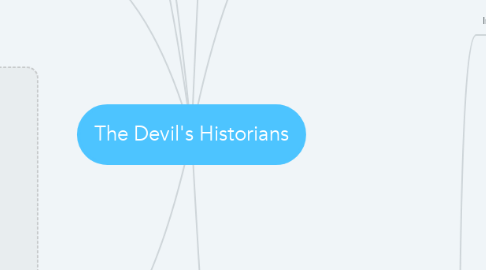
1. Evidence
2. Historians
2.1. Good
2.1.1. Amy Kaufman
2.1.2. Paul Sturtevant
2.1.3. Dorothy Kim
2.2. Bad
2.2.1. Edward Gibbon
2.2.2. Niall Ferguson
2.2.3. Samual Huntington
3. Thesis
3.1. Myths about the Middle Ages are a common part of culture, but do not represent an accurate (truthful) account of the medieval past historians have uncovered
3.1.1. The Middle Ages is Abused
3.1.1.1. For Nationalism
3.1.1.2. For White Supremacy
3.1.1.3. For Christian Supremacy
3.1.1.4. For Misogyny
3.2. We want to represent the diverse, multicultural, religiously tolerant, Middle Ages that existed (sometimes, but not always)
4. Argumentation Styles
4.1. Bring up common ideas and prove them to be myths. They have a way of making you feel like everything you know it wrong and they are the only ones able to show you the truth - or how to find the truth among lies.
4.1.1. Debunking common misunderstandings. This makes the reader feel at ease when they feel like they are now being taught the right way.
4.2. Bring to light "smaller" ideas (what's the big deal?) and prove that these are actually important and historians need to look at everything. Even small details can change the outlook in the era in history.
4.3. Exhibit the "evil" people who have "messed" up our notions and ideas of history. By showing the bad guys, they now seem like the good guys.
4.4. Pop culture references
4.4.1. Feel relatable and in the know.
4.5. Repetition! - This is what we believe = trustworthy + convincing
5. Authors
5.1. Trustworthy?
5.1.1. Appears to be very knowledge in many aspects.
5.1.2. I trust them. They bring up common misunderstandings which puts me at ease that I know have proper knowledge.
5.1.2.1. Absolutely shredding the common misconceptions in a very authentic way.
5.1.2.1.1. The wording sounds raw and true. Perfect for feeling content with being reassured you're not learning the wrong info now.
5.1.3. Academic and knowledgeable backgrounds shining through.
5.1.3.1. Many authors from different times referenced.
5.2. Amy Kaufman
5.2.1. Education?
5.2.2. Other writings?
5.2.3. Current Employment?
5.2.4. Social Media
5.2.4.1. https://twitter.com/drdarkage
5.2.4.2. Amy S. Kaufman, Ph.D.
5.2.4.2.1. Very active in pop culture and current events (in the US and Canada it seems). This makes me feel like I can trust her more. That she is "in the know." Also, she has her Ph.D. and was a professor. This results in trust that she has high academic knowledge.
5.2.5. Assessment
5.2.5.1. Focuses on shattering myths about women and gender in the middle ages
5.2.5.2. Former professor of classical and medieval literature
5.2.5.2.1. Left academia to write full time
5.3. Paul Sturtevant
5.3.1. Social Media
5.3.1.1. Paul B. Sturtevant | Homepage | Paul B. Sturtevant, Ph.D.
5.3.1.2. Blog | Paul B. Sturtevant, Ph.D.
5.3.1.2.1. Looking at his blog and Twitter, I feel like he is also very "woke" and knowledgeable about many different things. For example, I clicked on his blog post about Hamilton and felt impressed.
5.3.1.3. https://twitter.com/Past_Present
5.3.1.4. Founder of https://twitter.com/PublicMedieval
5.3.2. Author
5.3.3. Historian
5.3.3.1. Has PhD
5.3.3.2. Focuses on how popular culture shapes how we understand the past and present
5.3.3.3. Sturtevant has been in a BBC documentary, and has taught at different universities.
5.3.4. Speaker
5.3.5. Smithsonian
6. 2020 Context
6.1. Resurgence of Populism
6.2. Resurgence of Nationalism
6.3. Trumpism
6.4. Academic Employment Precarity
6.5. Desire to see multicultural, diverse identities/sexualities/races as part of the Medieval Past (cultural history meets the Middle Ages)
7. Structure
7.1. Introduction: Weaponizing History
7.1.1. Augustus Example (Misogyny is service of Empire)
7.1.2. Bayeaux Tapestry Example
7.2. 1. Middle Ages: Foundational Myths
7.2.1. Common Knowledge = Myth
7.2.1.1. Witch Trial = Modern
7.2.1.2. Malleus Maleficiarum (1487)
7.2.1.2.1. condemned by contemporaries
7.2.1.2.2. printed
7.2.1.2.3. actual witch trials = 1600s
7.2.1.3. Misdating allows us to think we are better than them.
7.2.2. Middle Ages are an invention
7.2.2.1. Renaissance creates MA
7.2.2.1.1. Leonardo Bruni
7.2.2.1.2. F. Biondo
7.2.2.1.3. Bussi
7.2.2.2. Renaissance Resentment towards Middle Ages
7.2.2.2.1. incipient nationalism (Germans ruined everything)
7.2.2.2.2. why did people stop using proper Latin?
7.2.2.3. Medievalism
7.2.2.3.1. Way of imagining/ representing the medieval past
7.2.3. Myth: Nasty, Brutish and Short
7.2.3.1. Hobbes quotation (17th century) describing society at war
7.2.3.2. myth: average age was 35
7.2.3.3. myth: they were more violent
7.2.3.3.1. Counterproof: WWII killed loads more
7.2.3.3.2. But was violence more normative? They don't address
7.2.3.4. myth: plague was the worst
7.2.3.4.1. counterproof: before 20th century disease was always prevalent... and we like the Black Death because so many good stories/ art made about it
7.2.3.4.2. Decameron
7.2.3.5. myth: everyone was dirty
7.2.3.5.1. well, the Vikings were clean at least (and too clean for the Anglo-Saxons...)
7.2.4. Myth: Uneducated and Illiterate
7.2.4.1. What made modernity so great?
7.2.4.1.1. Guttenberg
7.2.4.1.2. Martin Luther
7.2.4.1.3. Columbus
7.2.4.2. there were important Medieval Thinkers
7.2.4.2.1. #List
7.2.4.3. Medieval people were mostly illiterate though.
7.2.5. Myth: No Individuality
7.2.5.1. Myth: You don't get to be yourself
7.2.5.1.1. Kings: can't control your rights
7.2.5.1.2. Popes: can't control your thoughts
7.2.5.2. Renaissance tried to pass themselves off as creating a "new Man"(but this ignores how often medieval authors talk about the new "modern" man) (in a sexist way generally...)
7.2.6. Myth: White and Christian
7.2.6.1. evidence for non-white exists
7.2.6.1.1. #List
7.2.6.2. Does evidence for whiteness exist?
7.2.6.3. Does not address the Christian aspect too deeply.
7.2.7. Myth: Male and Hetero-sexual
7.2.7.1. admits women lack rights
7.2.7.2. BUT lots of women did more than generally depicted in medievalisms
7.2.7.2.1. #List
7.2.7.3. #LoveHasAHistory
7.2.7.4. #LGTBQ Middle Ages
7.2.8. Myth: Not relevant
7.2.8.1. If it were not relevant would you be reading this?
7.2.8.2. Aha!
